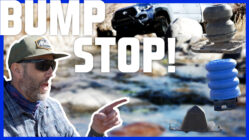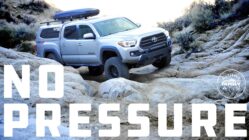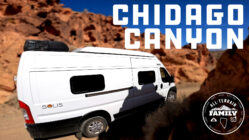So there are two schools of thought on how you can pack gear into, or in this case, on TOP of your truck for overlanding. First, and what seems to be most common, is to use a flat rack and cases and strap all your gear and tools there on top.
Second, and the method we prefer, is to use one of the many available roof boxes that strap to either the factory roof rack cross bars, or an after market cross bar from the likes of Yakima, Thule, FrontRunner, Rhino, etc. For whatever reason, these roof boxes are looked upon as Un-Overland. And I’ve detected derision on the social media and forums when it comes up.
Why Roof Boxes For Overlanding?
There are a couple of reasons we use our Yakima and Thule roof boxes over strapping gear to a flat rack. They are what works for us, and we have a system of packing for them and packing in them that works for us. Our style of overlanding suits the use of roof boxes and here’s why.

Roof Box Pro #1: Aerodynamics
Roof boxes are aerodynamic. Duh. Most of our overlanding adventures involve anywhere from a few hours to a whole day of highway time to get to the start. In the case of our recent Mojave Road trip, it was a full day and then some to get from Reno to Laughlin, Nevada where the trail starts. With the roof boxes we got 17 MPG in the Ford due to the fact that I had the roof boxes mounted such that they didn’t stick up over the roof of the cab. To do this I used a set of Yakima Bed Rock mounts and Yakima 72 inch round bars.
fact that I had the roof boxes mounted such that they didn’t stick up over the roof of the cab. To do this I used a set of Yakima Bed Rock mounts and Yakima 72 inch round bars.
Even on our Toyota 4Runner, the roof boxes only give us about a 1.5 MPG hit to efficiency. And as we all know, range is important for overlanding. Anything that can get you more range is a good thing.
Roof Box Pro #2: Ease of Use
Roof boxes are easy to use. Rather than packing a cargo pack, hefting that box onto the roof rack, climbing up and positioning it and strapping it down, then doing it all again for the rest of your cargo packs, I just open the lit, toss in some gear, close the lid and drive away.

Roof Box Pro #3: Cover
Everything that goes into my roof boxes stays dry. It keeps out most of the dust. Not all of the dust, but it isn’t bad. The fact that it keeps water off our gear, and even in gnarly storms, water doesn’t get in, is huge.
Roof Box Pro #4: Security
Your gear isn’t necessarily in a vault up there, but because there is a lock and that lock requires some amount of work, or tools to defeat (even WITH the key…) it’s by default more secure than gear strapped to a flat rack. Add in the fact that you can’t tell by looking at it whether they are fully loaded or completely empty, and you have something that encourages the casual thief to move on.
The Problem with Roof Boxes
Yes. I admit, there are issues with roof boxes for overlanding.
Roof Box Con #1: Hard To Close
The first issue with roof boxes is that they can be hard to close. Our Yakima has a better latch than the Thule, and generally is trouble free. The Thule however has a latch that you have to close with the key. It’s hard to grip and gear inside the box can easily block the 3 mechanisms and prevent it from latching. I keep a long boat strap in my tool bag, so for part of our Mojave Road trip I just lashed it down like you’d lash down a kayak. Whatever…
Roof Box Issue #2: Stability
I’m sure you’ve seen cars cruising around with roof boxes askew up top. They move around a bit. With any weight in them the inertia will shift them around, and when empty the wind will do it. In some of our videos you cans see our Yakima box shifting around on top of our 4Runner. Once it came all the way off the bar because I had it mounted outboard of the towers.
How To Keep Your Roof Box From Shifting
 It’s actually an easy fix. You a set of Yakima’s SnapAround Mounting Brackets and the bolts and nuts that go with them. You can purchase this stuff from Yakima, but chances are you have some sitting around. You only need two if you have your roof box butted up against the towers.
It’s actually an easy fix. You a set of Yakima’s SnapAround Mounting Brackets and the bolts and nuts that go with them. You can purchase this stuff from Yakima, but chances are you have some sitting around. You only need two if you have your roof box butted up against the towers.- Attach the bracket to the bar and thread in the bolt/nut.
- Slide it up against the roof box mounting point
- Tighten it down.
This will have a lot more clamping force and friction than the roof box mounting clamp and will keep your roof box stabile and in place no matter the load or road.












Add comment